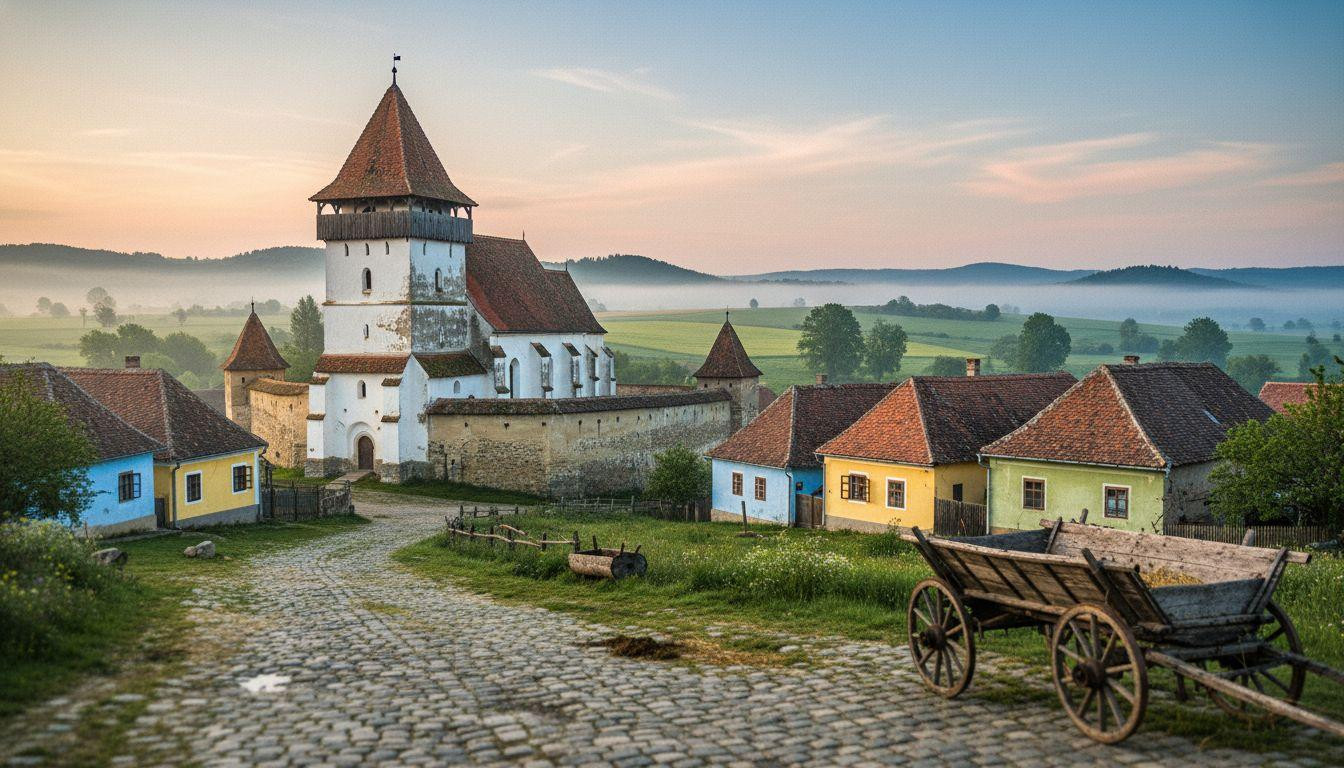Morning mist rises over Viscri’s white fortified church, its red tile roofs catching the first golden light. This Saxon village in Romania’s Transylvania preserves 900 years of heritage that Western Europe has commercialized beyond recognition. While Rothenburg ob der Tauber charges $200 per night for medieval atmosphere, Viscri offers the real thing for $75.
Seven UNESCO-protected Saxon villages dot the Brașov-Sibiu triangle, each within 50 miles of the others. These aren’t museum pieces performing for tourists. They’re living communities where blacksmiths still hammer horseshoes and church bells mark time as they have for centuries.
Viscri: where Prince Charles found his sanctuary
The cobblestone streets carry the clip-clop of horse carts and the soft murmur of Saxon German. Population 450, this village sits 28 miles northwest of Sighișoara in rolling green hills. Medieval fortified villages across Europe charge premium prices, but Viscri remains authentic and accessible.
Prince Charles discovered this place in 1998 and purchased House 68 next to the fortified church. His guest house now welcomes travelers seeking genuine Saxon heritage. The Viscri 125 hotel offers restored Saxon homes from the mid-1700s at $75 per night, breakfast included.
The fortified church that survived Ottoman sieges
Built around 1100 AD, the church rises like a white castle with defensive walls and wooden ramparts. Its red tile roofs contrast sharply against green Transylvanian hills. Inside, 14th-century frescoes and original wooden pews preserve Saxon Lutheran traditions.
The church served as fortress and sanctuary during Ottoman invasions. Villagers stored grain and valuables in its thick walls. Today, admission costs $3 and includes access to the church tower.
Living traditions in working workshops
The village blacksmith still operates from his century-old forge, crafting horseshoes by hand. Pottery workshops teach Saxon ceramic techniques passed down through generations. Traditional cooking classes with local families cost $25 and include recipes for Saxon sausages and hearty stews.
Visit between April and October when the church opens daily from 10am to 6pm. Castle-dominated villages throughout Europe offer similar medieval experiences, but few maintain such authentic daily life.
The Saxon village circuit: six more hidden gems
Biertan crowns a hilltop 42 miles southeast of Sibiu with massive three-ring fortifications. Its “divorce prison” once housed couples contemplating separation in a tiny room for two weeks. Historical records show only one divorce in 300 years using this method.
Prejmer, 11 miles northeast of Brașov, boasts the largest fortified church complex. Its 272 fortified rooms housed entire families during sieges. Population 8,000 makes it the largest Saxon village, yet it maintains intimate medieval charm.
Câlnic’s isolated tower fortress
Câlnic stands alone in wheat fields 22 miles northwest of Sibiu. Its single 82-foot tower rises dramatically from farmland. This 13th-century donjon represents unique Saxon defensive architecture. Fewer than 20 tourists visit daily, offering profound solitude.
Saschiz features a 141-foot Gothic clock tower from 1496, still keeping perfect time. Traditional bread-baking workshops occur Saturdays in wood-fired ovens. Whitewashed village architecture appears throughout Southern Europe, but Saxon cubic houses create distinctly Central European aesthetics.
Valea Viilor and Homorod: authentic extremes
Valea Viilor maintains the highest Saxon population percentage at 12%. German echoes from Sunday church services where traditional costumes appear monthly. Homestays cost $45-60 per night with families who’ve lived here for generations.
Homorod receives fewer than 50 annual visitors. Its Gothic fortified church from the 1300s sits in complete silence. No tourist facilities exist, making it perfect for photography without crowds. Stay in nearby Rupea, 9 miles away, for $50-60 per night.
Planning your Saxon heritage circuit
The optimal 5-day route begins in Sibiu and covers all seven villages. Total distance spans 200 miles of scenic Transylvanian countryside. Traditional craft experiences in each village showcase Saxon heritage through hands-on workshops.
Budget $75-95 daily including accommodation, meals, and admissions. Western European medieval circuits cost $180-220 for comparable experiences. Rental cars from Bucharest or Sibiu range $35-50 per day.
Visit April through October for optimal weather and church access. Summer temperatures reach comfortable 77°F with minimal rainfall. November brings misty mornings that create atmospheric photography conditions.
Your questions about Transylvanian Saxon villages answered
How difficult is driving between villages?
All seven villages connect via paved roads within a 60-mile radius. Driving times range 25-90 minutes between destinations. GPS coordinates work reliably, and road signage appears in Romanian and English. Compact cars handle rural roads adequately.
Do locals speak English in these remote villages?
English proficiency varies significantly. Viscri offers 90% English-speaking hosts due to tourism development. Homorod drops to 40% English speakers. German works better than English in villages with remaining Saxon populations. Tourist boards recommend carrying translation apps for cultural interactions.
How do these villages compare to Western Europe’s medieval destinations?
Transylvanian villages offer authentic daily life versus Western Europe’s commercialized presentations. Rothenburg charges $120-200 per night with tour bus crowds. Saxon villages cost $50-75 with genuine community interaction. Architecture remains functional rather than museumified.
Evening light fades over Viscri’s church tower while farmers drive cattle home on cobblestone streets. The Saxon villages hold medieval Europe in amber suspension, waiting for travelers who value authenticity over Instagram perfection.
